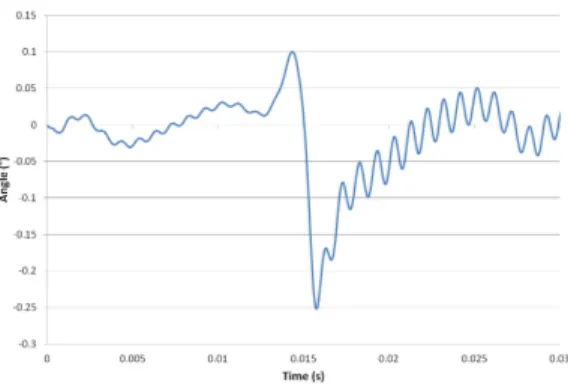11th World Congress on Computational Mechanics (WCCM XI) 5th European Conference on Computational Mechanics (ECCM V) 6th European Conference on Computational Fluid Dynamics (ECFD VI) July 20–25, 2014, Barcelona, Spain
CALCULATION OF CRANKSHAFT TWIST ANGLE USING
MULTIBODY SIMULATION AND FINITE ELEMENT
METHOD
Yannick Louvigny∗ and Pierre Duysinx1
∗ University of Liege, Aerospace and Mechanical Engineering Department, B52 Chemin des
Chevreuils 1, B-4000 Liege, Belgium, yannick.louvigny@ulg.ac.be
1 University of Liege, Aerospace and Mechanical Engineering Department, B52 Chemin des
Chevreuils 1, B-4000 Liege, Belgium, p.duysinx@ulg.ac.be
Key words: Applications, Finite Element, Engine dynamics, Torsion.
Facing environmental and energy challenges, governments require from the automotive industries to reduce exhaust emissions and fuel consumption. These requirements imply to have a very fine tuning of the combustion process. This tuning is only possible if the fuel injection and the exhaust valve timing are perfectly managed [1]. The injection and valve timing are based on the crankshaft angular position that does not take into account the crankshaft torsional deformations due to the engine torque. If the crankshaft twist angle is important, it can lead to a bad fuel injection timing or a poor synchronization between pistons and valves and thus to non-optimal engine operation. Moreover, bad valve timings can lead to contacts between valves and pistons and to engine breakdown. To make matters worse, the engine torque is not constant during the four-stroke cycle and this non-smooth operation can produce important torsional vibrations in the crankshaft. These vibrations can lead to crankshaft failure or to damages at accessories driven by the crankshaft. In this study, the twist angle of a crankshaft is determined using finite element method and multibody simulation. Dynamic simulations of a twin-cylinder boxer engine are carried out, in SAMCEF Field Mecano software, with rigid and flexible multibody models using the finite element approach [2]. The CAD drawing of the two pistons, two connecting rods and crankshaft are imported in the SAMCEF Field environment and the parts are linked together using appropriate kinematic joints. The gas pressure in the cylinder is modeled by resultant forces applied on the pistons upper face. Pistons and connecting rods are considered as rigid bodies while the crankshaft is modeled as a flexible part and meshed with brick elements. By considering the flexibility of the crankshaft, its strains and stresses can be calculated. Knowing the amplitude of the deformations, crankshaft twist angle and torsional vibrations (variations of twist angle) can be measured. Figure 1 presents crankshaft strains when the crank angle is three degrees after the top dead center and the combustion occurs in the cylinder furthest from the flywheel. To obtain this picture, the node displacements due to the strains had to be
Yannick Louvigny and Pierre Duysinx
Figure 1: Nodal displacements (amplified). Figure 2: Twist angle evolution.
isolated from the displacements related to the crankshaft motion. It had been possible because super element methods have been used in addition to the finite element method to model the crankshaft. The crankshaft twist angle, measured between the two crankpin, is then determined. Its value is obtained by calculating the difference of rotation angle between each crankpin central nodes. Figure 2 illustrates the variations of crankshaft twist angle during one complete four-stroke cycle. One notices that the twist angle is proportional to the instant torque produced by the engine as also noted in [3] and [4]. To study the dynamics of the engine in transient situation, simplified torsional models of the crankshaft (including super element models and beam element models), allowing faster simulations, are developed. To validate the accuracy of these crankshaft models, they are used in steady state simulations and the results obtained are compared to the ones obtained with the pure finite element model.
REFERENCES
[1] P. Kowalac. Experimental determination of low speed diesel engine crankshaft twist-ing. Journal of POLISH CIMAC, Vol. 3, 2008.
[2] M. Geradin, A. Cardona. Flexible multibody dynamics: A finite element approach. First Edition, John Wiley & Sons, 2001.
[3] W.J. Swanson. Determination of diesel engine cylinder gas torques from speed fluc-tuations with a high-fidelity crankshaft torsional model. Masters thesis, Naval post-graduate school Monterey, California, 1998.
[4] E.G. Giakoumis, C.D. Rakopoulos, A.M. Dimaratos. Study of crankshaft torsional deformation under steadystate and transient operation of turbocharged diesel en-gines. Proceedings of the Institution of Mechanical Engineers Part K: Journal of Multi-body Dynamics, Vol. 222, 2008.
